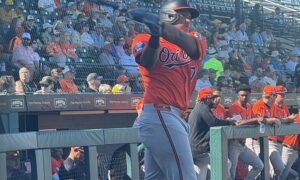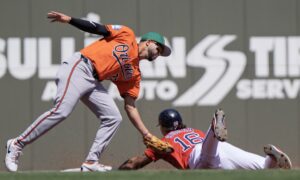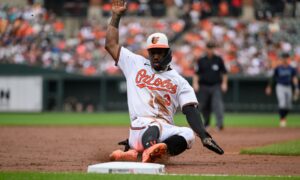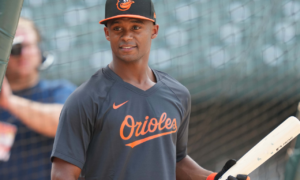Myriad O’s thoughts: Research went into Monday’s key play; Hart’s big spot; Bundy’s night
SCROLL DOWN TO READ ARTICLE
Perhaps the biggest play of the Orioles’ 4-3 win over the Washington Nationals on Monday appeared to be happenstance, a runner making a slight blunder and a defense capitalizing on it.
But it was more than that. It was planned, in a way.
In the eighth inning, Orioles sidearming rookie left-hander Donnie Hart was called on to face lefty Daniel Murphy, one of the best hitters in the National League.
The rookie immediately served up a leadoff double. With Bryce Harper, the reigning NL MVP at the plate, Hart remembered something from video about Murphy.
CONTINUE READING BELOW
“I was fortunate enough to see some film earlier today on one of the plays where the ball is hit back to the pitcher and (Murphy) took off running. So in that situation I kind of told myself, ‘Check him,’” Hart said.
Harper hit a comebacker, and instead of going to first for the easy out, Hart spun to see if Murphy was breaking toward third. He was. Once Murphy realized what was going on, he was stuck.
“And, sure enough, I got the ball back to me and I turned around and he had his head down going to third,” Hart said. “So it just so happened we were able to get him.”
Hart threw to J.J. Hardy, who tagged out Murphy (pictured above), setting up one out and Harper on first instead of one out and Murphy on second or third.
“I think it changed the inning,” Hart said. “But you’ve got to make those plays”
CONTINUE READING BELOW
That was it for Hart. He was replaced by Brad Brach, who allowed a walk and a wild pitch, but picked up a groundout and a strikeout of Ryan Zimmerman – in an impressive seven-pitch battle that included three foul balls – to strand Washington runners at second and third.
Big spot for Hart
Hart, a 27th rounder in 2013 who began the season at Double-A, has not allowed a run in eight appearances. None was as perilous as Monday night, facing Murphy and Harper in a one-run game. But, as Orioles manager Buck Showalter says, “Donnie ain’t scared.” Besides, he’s the Orioles’ only non-closing lefty in the bullpen.
“That’s my job. I don’t really look at it as anything other than that. My job is to come in there and get lefties out in big situations. That’s was one of them,” Hart said. “I think as a competitor that’s what you want, that’s what you look for and that’s my spot. That’s my job. If I’m going to keep my job, I’ve got to get those guys out.”
He only retired one of the two – but that’s not really the point. The point is Showalter easily could have gone to Brach to start the eighth. But he went with the 25-year-old, inexperienced Hart in a spot that the injured Darren O’Day normally would get.
“The way we are in the bullpen right now without Darren, every out we can get to keep guys from getting overtaxed, we have to take that chance,” Showalter said. “We’re going to have to have someone to do that job if we’re going to get where we’re going to get and there’s only one way to find out.”
Showalter’s right. These are the outs that loom big in September – matchup moments against guys like Boston’s David Ortiz. This was an early test to see if Hart can be ready for those situations. It was the right place and time. And solid results.
Bundy sharp enough to win his seventh
Monday’s six-inning, two-run performance wasn’t Dylan Bundy’s best. It was nearly his longest – he’s now lasted six innings twice and seven innings once.
It also set a career-high in pitches for the 23-year-old: 94.
Otherwise, it was not a particularly memorable performance. He allowed three hits, four walks, struck out four and hit a batter. His command wasn’t as sharp as it had been in some other outings and his velocity is down from his first few starts in July.
But Showalter said that, in a sense, is by design. Because Bundy is incorporating his two-seam fastball more into his repertoire, and that might be affecting his overall fastball velocity readings.
“I don’t think it is down that much. I know he’s throwing a lot more two-seamers,” Showalter said. “That must be what you’re seeing. He’s got more than just a four-seam fastball. I think he had some 95s, 96s. I don’t look at the gun much with him. I watch the other team.”
Here’s what a member of the other team, Murphy, said. It coincides with Showalter’s theory.
“He went away from what seemed like a four-seamer and started running it a little bit. I didn’t see him do that a ton on the film, so to kinda switch up on the fly right there was impressive,” Murphy said. “He rode it a little more in the first time through the lineup, then he started running it later on. He went from about 94, 95 first time through the order to about 90, 92 the second time. He’d geek it up a little bit when he got in a spot.”
Bundy has said constantly that the most important thing for him is to command all of his pitches, so that if one isn’t working he can rely on others. His curveball and changeup helped get him through Monday’s outing.
“It was one of those nights I had to battle. I was missing off the corners a little bit, not as bad as the past two outings, but I was missing some,” he said. “I had to battle through a leadoff walk, a leadoff double, stuff like that. It just makes you better in the long run, I think.”
4 Comments
You must be logged in to post a comment Login or Register Here
Leave a Reply
You must be logged in to post a comment.










